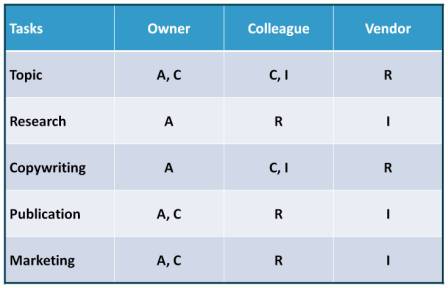If you are a fan of shows featuring creative types – Top Chef, Project Runway and others – you may have noticed a pattern.
- What challenge do they ALL hate?
- The team challenge
- It’s especially challenging to the Control Freak
In Part 6 of a 10-part series for creating a business communication plan, we assign roles and responsibilities.
We dedicate this post to the Control Freak.
Present company included.
Master of Disaster
Let’s face it.
There’s a bit of the Control Freak in all us.
Otherwise, we wouldn’t be business owners. Even if you’ve gone through this exercise and found your budget is as small as your business, it doesn’t mean you have to do it all.
We all need some form of help with our business communications.
- A business writer for putting our dreams into words
- The guest blogger with something of value
- The business colleague that reviews and shares feedback
- The network to share our message
When creating your plan, don’t forget the unsung heroes that save you time and money.
Being in control does not mean you master it all.
Not unless you want to become the Master of Disaster.
The Xs and Os
Assigning roles and responsibilities is like the Xs and Os of a game plan.
- It’s a visual depiction of the specific play
- It allows each player to know his or her role and responsibility
- It puts all the team on the same page
More than one coach has been accused of being a Control Freak. But, one thing is certain – the coach needs the players to win the game.
A common Xs and Os method for assigning roles and responsibilities is the RACI model.
- R = Responsible – who does what task
- A = Accountable – where the buck stops (that would be you, business owner)
- C = Consult – the expert help, the one whose opinion you value
- I = Inform – the people who need to know what’s happening
See, there is always a place for the Control Freak – and it comes with a giant “A.”
- You aren’t surrendering control
- You are managing your business communications
Game Time
- You created your vision statement
- You identified your targeted reader – your ideal client
- You have your objectives
- You know your budget
- You know the type of communication vehicle
Now what?
Caught you napping, huh? Assign roles and responsibilities.
Let’s look at an example of tasks associated with a ghostwritten article with the business owner’s byline.
To make this simple (and you know how I love simple), we’ll categorize individuals as:
- Owner – business owner, small or large
- Colleague – employee or colleague performing task
- Vendor – a freelance business writer
In the above example, the assignment assumes the following:
Topic
- The topic will be created by the owner
- The owner is consulted with on any questions about the topic
- The owner will consult with employees on the topic or inform them of the subject matter
- The vendor is responsible for writing the article based on the topic
Research
- The owner is accountable for overseeing the research
- The employee is responsible for conducting the research
- The vendor will be provided with research results
Copywriting
- The owner is accountable for approving the copy
- The owner is consulted with regarding questions on copy
- The employee consults on copy (editing)
- The employee receives copies of drafts/final copy
- The vendor is responsible for creating the original copy
Publishing
- The owner is accountable for overseeing the publication of the article
- The owner is consulted with over questions of publication
- The employee is responsible for getting the article published
- The vendor is informed of the publication
Marketing
- The owner is accountable for the marketing of the published article
- The owner is consulted with on questions regarding marketing
- The employee is responsible for the marketing activities
- The vendor is informed about marketing activities
Why bother?
What happens if –
- The owner assumes the freelance writer handles the shopping of the article for publication?
- Or the owner thinks the marketing is done by the writer?
The owner is not a happy camper when he or she receives a bill for the extra services.
Communicate about your communication.
None of us like surprises.
Next up, we’ll look at developing your message.
=====================
This is Part 6 in a 10-part series for developing a business communication plan. I would love to have your feedback. Please share those in Comments.
=====================
Prior Posts in Series
Part 1 – Does Your Vision Statement Reflect Your Dream?
Part 2 – Learn From Lieutenant Colombo to I.D. Your Killer Client
Part 3 – Why Blind Hog Business Communication Objectives Don’t Work
Part 4 – Busting 3 Budget Myths for Your Business Communication Plan
Part 5 – Are Your Business Communication Vehicles Driving You?
Follow-up Posts in Series
Part 7 – Does Your Message Stink From the Headline Down?
Part 8 – 3 Chopped Lessons for Your Business Communication Timeline
Part 9 – Is Your Hamster Wheel Business Communication Getting You Nowhere?
Part 10 – Do You Have Your Business Communication on Autopilot?
=====================
Helping you Keep it simple, clear & uniquely yours – contact me for help with your business writing needs.
=====================




Great post! You’ve succinctly outlined how and why to delegate.
Thanks, Tea. I appreciate the kind words and the RT. 🙂
Cathy – one challenge though is that most small business owners have no one to delegate to and yet there is so much they are unable to do on their own. How do you think this should be handled.
Hi Roberta. I’m one of those small businesses. In Part 4 of my series, I offered some “shoestring” budget suggestions.
You can share services with a colleague. For example, ask a writer friend to “proof” your business communication. You do something for them in exchange.
Use college students for research. Many of them love earning an extra buck, do not charge huge amounts, and are great at research.
Often, it is more costly for small business owners to do it themselves (in terms of the amount of time it takes away from their business). You can’t know you cannot afford to outsource if you never create a budget, figure out the time spent and explore your alternatives.
Would love to hear other ideas from readers. Thanks, Roberta.
In the company I work for, there are two of us–team leader and team-me. I ghost for our clients. I decide the topic, do the research, write and post the articles. Occasionally a client will ask for specific posts, but in general I do all that stuff myself. I don’t get the clients, but I think I do some of the marketing. Not sure.
Ann-As a sole proprietor, I understand the team me. BTW, love that term, I am going to have to steal, er, borrow it. 🙂
How is all that working for you? Sounds like team me could use some assistance. Thanks for sharing your world, Ann.
Great post! I needed to hear this. You need to be somewhat of a control freak to run your own business, but there is a line to be drawn. Sometimes it’s hard to see where the line is though!
Thank you, Anthony. I’m right there with you. 🙂 I still struggle with loosening up on the reins. Thanks for stopping by and sharing your view.